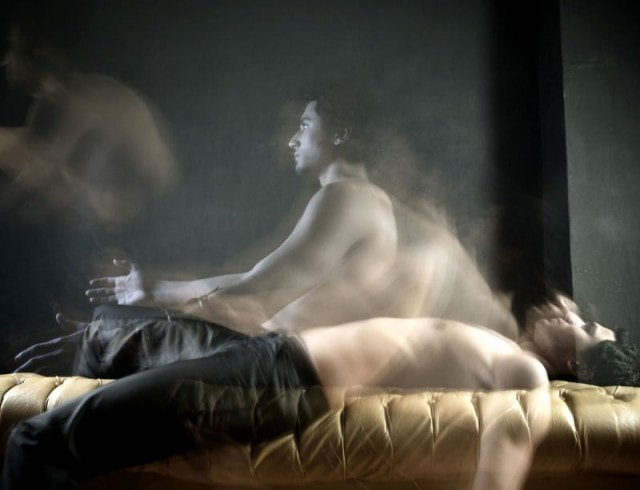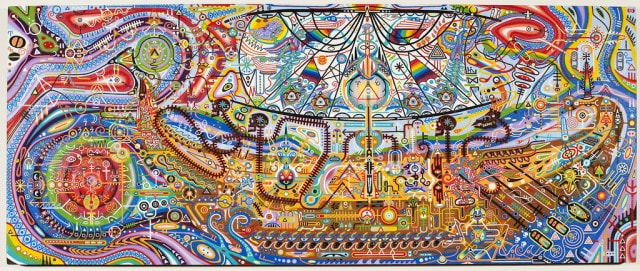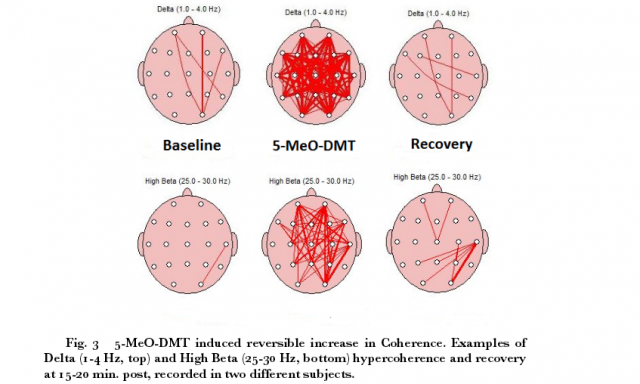While I enjoyed the presentation as it provided insights into yet another endogenous compound (Dynorphin) that correlates with significantly altered states of consciousness, I found that there seem to be some missing pieces to Nichols’ research that might provide deeper insights to the “Endohuasca” puzzle and NDE’s.
I’ve used the term “Endohuasca” in the past to describe some of the endogenous compounds that might provide the answers to generating altered states of consciousness without exogenous chemical stimulants. We cited not only N,N-dimethyltryptamine (DMT), 5-methoxy-N,N-dimethyltryptamine (5-MEO), and 5-HO-DMT (Bufotenin) but also the endogenously produced mono amine oxidase inhibitors (MAOIs) known to date (MAO-AI’s: Pinoline, Tryptoline, Harmane, Neurocatin, Tribulin A, Isoquilonium Derivatives (Salsolinol, 1MeTIQ) & MAO-BI’s: Phosphatidylserine, Quinolinic Acid, Tribulin B).
*Rines is a MAO-A activity regulator.
While the shamanic brew, Ayahuasca is comprised of a N,N-DMT containing plant (Psychotria Viridis) and a MAOI containing plant (Banisteriopsis Caapi), the “Endohuasca” system appears to have many “moving parts”. I would even venture to state that endogenous compounds such as Adrenochrome, Morphine, and Dynorphin have the potentiality to be “in play” alongside the DMT’s and MAOI’s during our moments of “Endohuasca activation”.

Nichols’ general premise is that N,N-DMT has no known significant role in the body. He also presents the case that since pinealectomy (surgical removal of the pineal gland) doesn’t produce any significant changes in normal functioning (disputable on numerous levels), that it doesn’t appear that the pineal gland is as important as it’s been built up to be. Here are the conclusions he presents with my perspective outlined directly under:
(Nichols)
1 – DMT is not produced in concentrations significant to activate CNS-5HT2A receptors, and is rapidly broken down by MAO if it is produced.
(DMT Quest)
In 2013, the Journal of Neuroscience published a study confirming the notion that activation of the 5-HT2A receptor underlies the visual hallucinations from psilocybin ingestion. An unconnected study in 2012 observed that 40mg of Ketanserin effectively suppressed the effects of psilocybin in humans. LSD-Ketanserin studies have also been published with similar projected results but from my knowledge there haven’t been any human studies to date. It is much more difficult to quantify the effects or subsequent suppression of the effects of psychedelics in non-human models.
If activation of the 5-HT2A receptor is truly the dominant mechanism for all psychedelic induced visual hallucinations, it would seem that utilizing 40mg of Ketanserin would effectively suppress experiences during Ayahuasca and potentially “Endohuasca” as well. In 2016, the journal European Neuropsychopharmacology would publish a study regarding the effects of 40mg of Ketanserin (5-HT2A antagonist) as it pertains to a medium dose of Ayahuasca. The study found that instead of the complete suppression of the effects as seen in the psilocybin study, there was only a 62% reduction in Affect, 56% reduction in Perception, and a 36% reduction in Intensity.
These results are intriguing as it alludes to the fact A) the effects of DMT might potentially correlate with receptors other than 5-HT2A and B) monoamine oxidase inhibitors (MAOIs) could possibly play a key role in hallucinatory activity outside of simply the suppression of DMT via deamination. A 1990 study in the Journal of Neural Transmission would observe changes in the number of Ketanserin binding sites from Tribulin derivative Isatin (an endogenous MAOI). A 2000 study in the journal Antioxidant and Redox Signaling would observe a 16.9% decrease in ketanserin binding to 5-HT2A receptors in the frontal cortex of mice from Gingko Biloba (which contains MAOI Kaempferol).
There are also the factors of DMT/5-MEO/Bufotenin and their numerous known receptor affinity other than 5-HT2A such as: 5-HT7, 5-HT1D, 5-HT2B, Alpha-2B, Alpha-2C, D1, 5-HT2C, 5-HT1E, 5-HT6, 5-HT5A, Imidazoline-1, Alpha-1B, Alpha-2A, Alpha-1A, SERT, Sigma-1, 5-HT1A) as well as hundreds of orphan G-protein-coupled receptors (GPCRs). There also lies the potentiality for DMT/5-MEO/Bufotenin affinity for Trace Amine-Associated Receptors (TAARS) and Metabotropic Glutamate receptors (mGluR2).
In essence, I wouldn’t place so much emphasis on one receptor (5-HT2A) based on the fact that Ketanserin failed to provide full spectrum suppression of the effects of a medium dose of Ayahuasca. Coupled with the fact that 5-HT2A antagonist binding sites seem to be altered by MAOI’s only complicates the matter even further.
We’ll address the rapid breakdown of DMT(s) by MAO later on in this piece.
(Nichols)
2 – There is no evidence to suggest that DMT can be accumulated in the brain or within neurons at significant concentrations; such inferences either are not supported by direct experimental evidence or are based on flawed experiments.
(DMT Quest)
My perspective of the activation of the Endohuasca system (which includes but is not limited to N,N-DMT) is that the measurement would need to retain the utmost integrity of the precise physiological environment in order to get an accurate reading. I don’t believe this is possible utilizing our current methods of measurement.
What I mean by this is that in speculating that “dream sleep” correlates with upregulation of Endohuasca release… that there is a correlation in increased cranial cerebrospinal fluid (CSF) volume/pressure, cerebral blood flow velocity, rhythmic respiratory function, SCN oscillation increase, ionic fluctuations, and many others. In order to accurately measure whether DMT/5-MEO/Bufotenin can exist in “significant” concentrations in the brain, we would need to be able to take live samples of hundreds (maybe thousands) of locations within the brain during these “dream sleep” moments without disturbing the natural fluid exchange/equilibrium that coincides with these states. Any deviation from the natural state allows the potential for reactions that are unaccounted for. This is essentially impossible as we would need to crack open a human skull while they are still alive and take brain tissue samples real-time during the moments of “dream sleep”. We must remain cognizant of our equipmental limitations as it pertains to realistic and accurate postulations for both sides of the discussion.
We must also remain aware that the effects of exogenous N,N-DMT are not only directly related to the compound itself but also the cascade effect it has on other biochemical release such as corticotropin, cortisol, prolactin, and growth hormone. The human body is an unequivocally complex symphony of electrical and biochemical activity which makes it extremely difficult and perhaps overly reductionist to attribute a cascade effect to one specific compound.
It can be the initial catalyst but is not responsible for everything…

I’d be interested to see future studies monitor the levels of dynorphin following Ayahuasca, DMT, and 5-MEO/Bufotenin administration. Much like Nichols’ cites endorphin/dynorphin release during stress… it’s been observed that endogenous monoamine oxidase inhibitors (MAOI’s) such as Tribulin, Pinoline, and Harmane are also activated during stress exposure. Perhaps this adds some value to speculation of the DMT’s role during these altered states?
In the video below, Dr. Steven Barker discusses data from the unpublished dissertation by Dr. Robert Harrison of the University of Alabama at Birmingham. Barker states that rats placed in stressful conditions of swimming to exhaustion or kept in isolation exuded greater levels of N,N-DMT in their brains as well as adrenal glands. He also described an experiment in which LSD was administered to rats which subsequently increased their endogenous levels of 5-MEO-DMT by 1000% and N,N-DMT by 400%. According to Barker, Dr. Harrison’s untimely death was the reason for the lack of publishing of these studies.
There lies the possibility that dynorphin and DMT/Endohuasca play a role in mediating the phenomena during severely altered states of consciousness.
(Nichols)
4 – Asphyxiation or cardiac arrest paradoxically lead to brain activation and result in marked increases of brain neurotransmitters such as dopamine, norepinephrine, and serotonin, the latter of which can stimulate 5-HT2A receptors.
(DMT Quest)
I agree with this data but do not feel that it excludes upregulation of the Endohuasca system. The fact that Ayahuasca administration results in a marked increase of the same brain neurotransmitters (dopamine, norepinephrine, serotonin) doesn’t negate the fact that N,N-DMT and MAOI’s are playing a chemical role in this stimulatory effect. There are also physiological, electrical, and anatomical correlates that coincide with asphyxiation that provide a layered catalyst to induce the subsequent effects. Chemical release is but one layer of the NDE…
*It’s interesting to note two separate studies (Brain Research 1985 & Physiology and Behaviour 1987) that showcase the reversal of the analgesic effect of 5-MEO-DMT when norepinephrine levels are depleted.
In essence… this is quite a complicated orchestra.
(Nichols)
5 – Asphyxia induces excessive release of the excitatory amino acid, glutamate. Drugs such as ketamine, which also raise cortical glutamate, can produce out of body experiences.
(DMT Quest)
Nichols is 100% correct in this instance. However, in order to understand the strange circus that is the human body a deeper peer must be taken into account. In the first point of his conclusion he stated “DMT is not produced in concentrations significant to activate CNS-5HT2A receptors, and is rapidly broken down by MAO if it is produced.”
This would lead us to believe that if there is an underlying mechanism in which our MAO activity could be suppressed via endogenous mechanisms, there lies the potentiality that DMT could be preserved for long enough to subsequently provide a significant effect.
A 1995 study in the journal Free Radical Biology & Medicine observed that elevated extracellular glutamate increased the formation of hydroxyl radicals (•OH) in the striatum of anesthetized rats. An unrelated 1995 study published in the Journal of Neurochemistry found that following brain injury there was an increase in both glutamate and hydroxyl radicals (•OH). The researchers stated: “The magnitude of glutamate release is correlated with the extent of the hydroxyl radical adduct, raising the possibility that the two responses are associated.”
The importance of the glutamate-hydroxyl radical relationship could be key in understanding the Endohuasca system. This is based on a 2001 study published in the journal Life Sciences titled, “Inhibition of brain monoamine oxidase (MAO) activity by the generation of hydroxyl radicals”. The results were as follows: “Results showed that the generation of •OH (hydroxyl radical) significantly reduced both MAO-A (85–53%) and MAO-B (77–39%) activities, exhibiting a linear correlation between both MAO-A and MAO-B activities and the amount of •OH produced. The reported inhibition was found to be irreversible for both MAO-A and MAO-B. Assuming the proven contribution of MAO activity to brain oxidative stress, this inhibition appears to reduce this contribution when an overproduction of •OH occurs.”
While there lies the potentiality that I’m way off base… if asphyxia induces excessive release of glutamate… and glutamate increases the formation of hydroxyl radicals (•OH)… and hydroxyl radicals (•OH) reduce both MAO-A and MAO-B activity up to 70-80%… and MAO is predominantly responsible for the breakdown of DMT’s… then there lies the possibility that DMT preservation and activation is “in play” during these glutamate spike moments. It wouldn’t be too far-fetched to presume this based on the observations that DMT has displayed neuroprotective effects against hypoxia.
Since we’re on the topic of glutamate we might as well cite other instances in which significant increases in glutamate take place. A 2002 study in the journal Critical Care Medicine would observe a nearly 400% increase in cerebral extracellular glutamate levels from baseline due to 30 minutes of hyperventilation. A 2008 study in the American Journal of Physiology – Regulatory, Integrative, and Comparative Physiology observed significant fluctuations of glutamate levels in the posterior hypothalamic region of the brain during REM sleep onset. As outlined extensively in the piece “Measuring DMT Formation in Humans” we present the evidence that respiratory fluctuation (loud, thunderous snoring) during sleep cycles appear to directly coincide with the most prominent/vivid dream states (REM sleep). We also speculate that induced altered states from respiratory techniques such as Wim Hof Method, Holotropic breathwork, and traditional yoga such as Pranayama are likely based on similar mechanisms.

During the presentation, Nichols postulates that the surge in brain activity during NDE’s is a mechanism in which the body is attempting to “fix” problems throughout the body. While this could very well be possible… it’s also quite possible that the Endohuasca system is extremely active during those moments simply from observing the significant suppression of MAO activity from hydroxyl radical formation due to glutamate spikes. It would be interesting to observe what effects hydroxyl radicals play on endogenous monoamine oxidase inhibitor levels. That’s a study that needs to be made in the future.
For evidence that there appears to be an upregulation of pineal gland activity during moments of stress, a 2008 study in the Journal of Cerebral Blood Flow & Metabolism observed a 500% increase of melatonin in the cerebrospinal fluid following traumatic brain injury. Interestingly enough, melatonin levels in the blood increased only 50% by comparison. This is important to note that this is proof of not only increased pineal function as an attenuation mechanism for brain injury but also the discrepancy between the levels of biochemical measurement amongst 2 different fluids. I would presume that the timeliness and area of the measurement in congruence with injury might also showcase a distinct fluctuation.
While not directly related to DMT release during induced stress, Pinoline has been identified as an endogenous MAOI that is formed from 5-methoxytryptamine (5-MeOT) which is a metabolite of melatonin. Perhaps surges in melatonin lead to increased pinoline synthesis which suppresses monoamine oxidase activity leading to the subsequent effects?
*I forgot to mention earlier that alongside the DMT’s and endogenous MAOIs, I believe that melatonin is a form of biomarker for Endohuasca activation and therefore belongs in the stew. While not particularly psychoactive by any means, it seems to act like an important modulator of sorts… one cannot create a proper bowl of Endohuasca without a punch/pinch of melatonin! The levels of this compound have also been observed to surge in conjunction with increased levels of stress. *To complicate things even further… melatonin is not solely produced in the pineal gland. It has also been observed to be synthesized in astrocytes, glial cells, lymphocytes, retinal cells, digestive tract, testes, ovary, placenta, skin, bone marrow cells, mast cells, and epithelial cells… many of them being independent of photoperiod.
*A 2014 review in the journal Cellular and Molecular Life provides data regarding the fact that the amount of extrapineal derived melatonin is much greater than that produced by the pineal gland. This refutes Dr. Nichols’ assertion of total daily melatonin production of 28.8μg based on blood sampling measurements from a 2001 study. It points to the fact that attempting to extrapolate blood sampling results as an accurate barometer for total production is overly simplistic by nature. Similarly to melatonin, there is the potentiality that DMT(s) are synthesized throughout the central nervous system and brain via astrocytes then released at the site of action.
(I rarely focus on the pineal gland as it is a limiting discussion in terms of the biology of “mystical” states. This is not to “knock” anyone who has interest in the organ but my perception is that based on it’s anatomical location (in the middle of the head), it makes it an inherently difficult organ to study in an economically viable and ethical manner (especially in humans). It does appear clear that the entire endocrine system as well as the heart, lungs, digestive system, and brain all play critical roles in the mystical experience if you look deep enough. The best thing about taking into account many different parts of the body is… there are thousands of studies of these additional organs. In essence, it opens up interpretation of mystical states based on each separate organ function during these moments. However, this doesn’t equate to the pineal gland lacking in importance. It’s just that in a strict scientific sense it will be relegated to speculation for many decades to come in terms of human studies due to being dangerously invasive. If the 2013 rat study by Dr. Steven Barker did not provide enough proof that there is a pineal/DMT relationship, there will be no study that will provide enough evidence for the skeptics. While it might be considered blasphemous to include anecdotal reports in a scientific discussion, in the piece “Random Facts & Speculations” we present the case of pituitary tumors leading to abnormally high levels of growth hormone which induces gigantism and acromelagy. An artist by the name of Shawn Thornton suffered from a tumor of the not the pituitary gland but rather the pineal gland. Thornton would produce artistry that could be described as psychedelic in theme with some overlap with artistry inspired by Ayahuasca and exogenous DMT ingestion. We propose the theory that if melatonin is the only (or predominant) secretion from the pineal gland, it would hardly make sense that Thornton experienced psychedelic visions from this tumor growth. Melatonin even at extremely high doses has not been observed to induce visionary hallucinations in a clinical setting. While there lies the possibility that there was no increased DMT secretion due to Thornton’s pineal gland tumor, it would seem rather difficult to make the case that dynorphin secretion was the cause of his visionary states. Nevertheless… the changes within the body on an electrical level is where I believe the future (and the past) of science lies in my eyes… but they must be tied with the other layers of chemical, genetic, fluid composition, magnetic, and many others I can’t think of currently.)
(Piece of art titled “Witch Doctor At The Eye of The Solar Epoch” by Shawn Thornton)

(Nichols)
6 – Although the romantic notion that DMT is released from the pineal gland to produce altered states of consciousness at various times of stress is appealing to some, science and logic suggest that other, more well studied systems provide more sound explanations for out of body experiences.
(DMT Quest)
I’m not going to lie… this last note comes across as a bit condescending. I’m not sure whether Nichols meant for this to come across as such but the notion that “science” and “logic” would suggest other “well studied” systems provide more sound explanations for out of body experiences seems a bit… incomplete.
The human body can hardly be reduced down to one receptor or one chemical. I think in this regards I am in agreement with Nichols that it is not just the pineal gland or just DMT that induces these extraordinary experiences. I believe that it is potentially the combination of everything that he has presented, information many other researchers have discussed, some studies that I have presented throughout this site, and likely much more that is taking place during these significantly altered states of consciousness simply from a biochemical perspective. There are many additional layers of the body that must be taken into account during these moments that should be focused upon… especially the electrical component in my humble yet not so humble opinion.
Reductionism whether it be in favor of the dynorphin hypothesis or the DMT hypothesis is still reductionism. It fails to take into account the enormous amount of nanosecond reactions taking place constantly throughout the body at all times. It fails to perceive the body as the ultimate gumbo of chemicals that change levels based on our respiration rhythm and depth, our visual stimulation or lack thereof, our audio stimulation or lack thereof, olfactory excitation, and many other less obvious external inputs.
In the words of Dennis Mckenna… “symbiosis” dude!
(Yes, symbiosis describes the relationship between two different biological organisms. However, sometimes it feels as though the predominant, modern scientific perspective is to perceive the body’s many layers as well as external environment as separate from one another… hence the use of the word. Don’t believe me? Come down with a mysterious ailment and simply observe the effective communication (or lacktherof) between the endocrinologist, pulmonologist, and gastroenterologist.)
Just a random guy’s 2 cents…
(Note: In Dr. Rick Strassman’s study published in 1994, he administered four different levels of N,N-DMT to volunteers… 0.05mg/kg, 0.1mg/kg, 0.2mg/kg, and 0.4mg/kg. While the higher “breakthrough” doses have seemed to garner the most attention, I believe there was some profound information derived from the sub-psychedelic doses. Here is an excerpt from Strassman’s book “DMT: The Spirit Molecule”: ‘The lowest dose of DMT, 0.05mg/kg, was pleasant, and almost all volunteers said they felt like smiling or laughing after receiving it. One volunteer who previously had used heroin thought this dose felt something like that drug: “There was a warm cotton batting sensation.” A few people experienced relatively intense effects from this little bit of DMT we gave on the first day. This warned us that the next day’s large dose might be especially powerful.’ – (End excerpt). I pose the question… if low, sub-psychedelic doses of N,N-DMT spur the effects of smiling, laughing, and feelings of overall well-being… who is to say that there isn’t a more subtle yet highly functional role of DMT within the brain/body on an emotional level? How could such a theory ever be proven or disproven for that matter? Let us not reduce N,N-DMT down to an all (“breakthrough”) or nothing concept. That would be reductionism on top of reductionism.)
Gamma Band Data:
Nichols cites the 2013 PNAS study that measures brain activity during induced cardiac arrest in rats. It was observed that a large surge of gamma power (25 to 55 Hz) and global coherence occurred at near-death. He speculates that the brain is going on “overdrive” in an attempt to fix issues taking place in the heart.
The gamma wave activity is intriguing based on the 2015 study in Cosmos & History regarding the EEG measurement of exogenous N,N-DMT, 5-MEO-DMT (synthetic), and Bufo-5-MEO-DMT (derived from Bufo Alvarius) administration. It was observed that all three DMT’s increased gamma power significantly and rather consistently. Also, very significant reversible hypercoherence in multiple bands were measured in most subjects.
(Figure 3. from the Cosmos & History DMT(s) study)

In addition to the EEG data from the DMT’s, there are multiple studies showcasing increases in global coherence as well as increase in the gamma frequency from Ayahuasca: Phytomedicine – 1998, MAPS – 2001, Journal of Psychoactive Drugs – 2005, and the Public Library of Science – 2015. It seems as though Nichols might have inadvertently supported the notion that DMT(s) might play a key role in the near death experience by citing the EEG data from induced cardiac arrest in rats. As far as I am aware… there have been no EEG studies of humans that have been administered dynorphin. However, it appears as though there are at least 8 combined EEG studies of Ayahuasca and DMT.
I believe scientific speculations should be based on the best available data that exists to date. From everything that is available right now (July 13, 2017) there is more robust information pointing to a combination of monaomine oxidase inhibition and DMT(s) release that lead to the measurable brain activity (gamma wave coherence) that coincides with the near-death-experience than there is on predominantly endorphin release.
But as stated prior… it’s likely both.
A biochemical cioppino if you will…
PS. This isn’t an attack on Dr. Nichols whatsoever. This is just a continuation of an important discussion that’s taken place for thousands of years… what are the mechanics of these mystical experiences?
DMT Quest is a non-profit 501(c)3 dedicated to raising awareness and funds for endogenous DMT Research. This specific field of psychedelic research has been underfunded for many decades now. It’s time to take our understanding of human physiology, abilities, and perception to the next level. E-mail me at jchavez@dmtquest.org with any comments or questions. You can also follow us on Facebook, Instagram, or Twitter.
.
